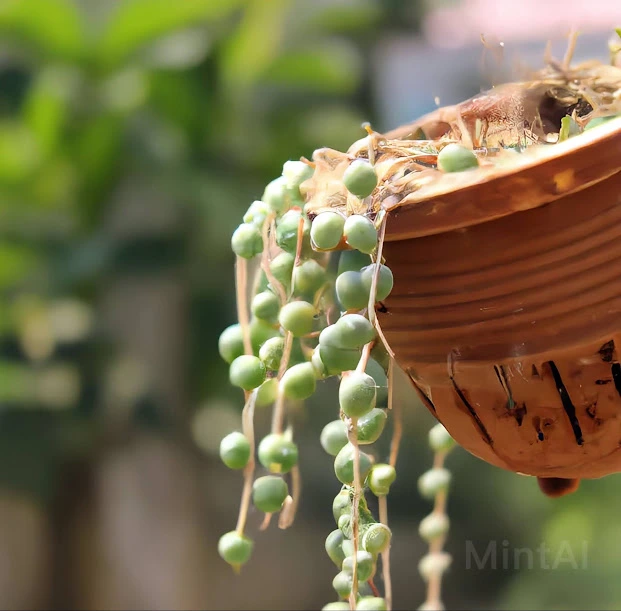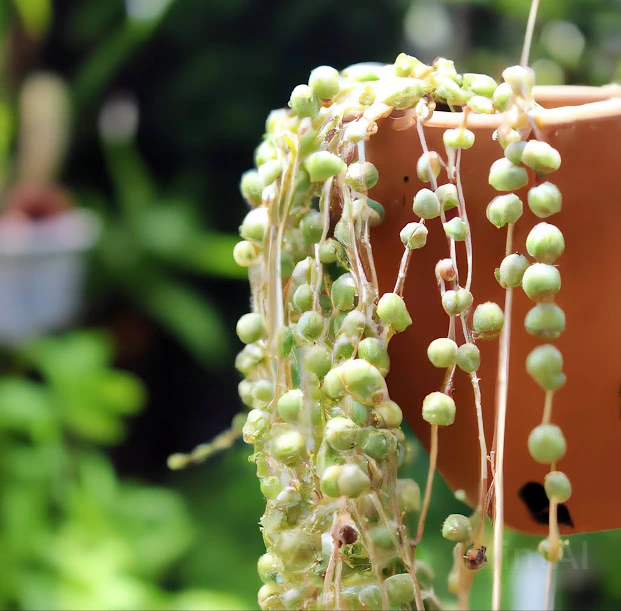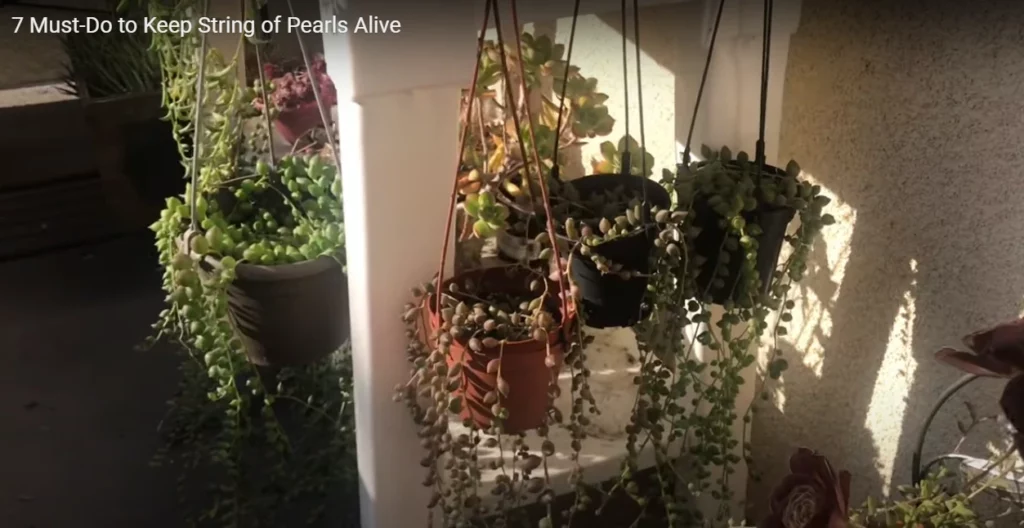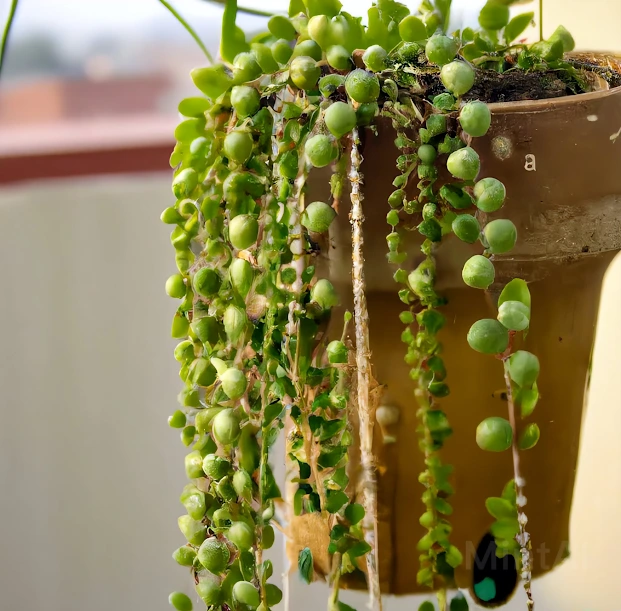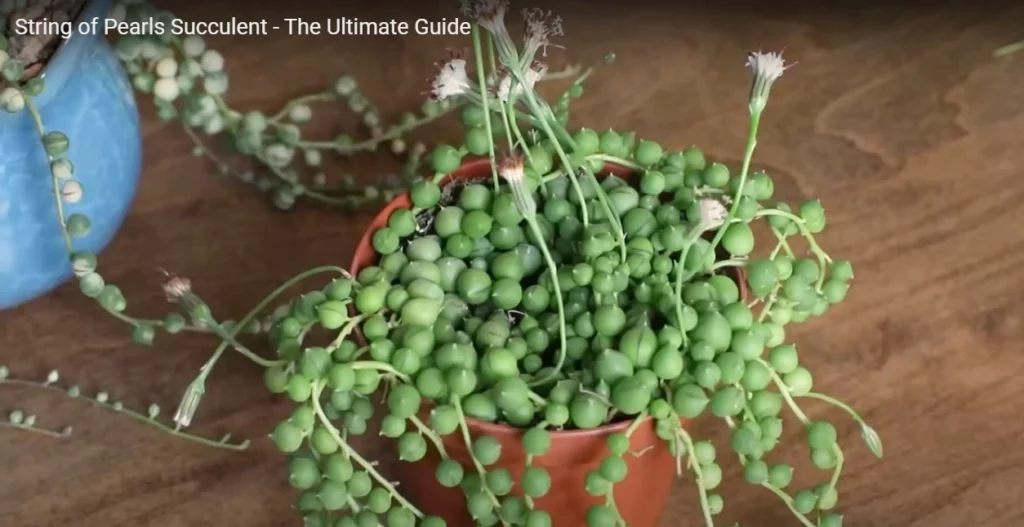Here you will find quick care tips on the string of pearls plant, what makes the plant yellow, stopping its growth. What kills your string of pearls, and makes it lose beats?
And a complete guide on the watering schedule, sunlight needs, pruning, soil, and fertilizer needs of this cute succulent.
Dying String of Pearls: Symptoms, Reasons and Fix
Symptoms of a Struggling String of Pearls:
- Yellowing Pearls: When your String of Pearls starts to lose its vibrant green color and the pearls turn yellow, it’s a sign that something isn’t right. This can indicate stress, overwatering, or insufficient light.
- Wilting Strands: If the typically plump, bead-like leaves begin to look deflated and saggy, it’s a sign of water stress. Either the plant is receiving too much water, leading to root rot, or it’s not getting enough moisture.
- Drooping Pearls: When the pearls on your String of Pearls start to droop and lose their characteristic roundness, it’s an indication that the plant is not getting enough light. It’s reaching out for more light, causing the stems to elongate and the pearls to lose their shape.
Why My String of Pearls Is Dying
- Overwatering: The string of Pearls is a succulent plant that is adapted to survive in dry conditions, so overwatering can cause the roots to rot and lead to the death of the plant. Reduce the frequency of watering and allow the soil to dry out between watering.
- Underwatering: While overwatering can be harmful, underwatering can also cause the plant to die. If the soil becomes too dry, the leaves may turn yellow or fall off, and the plant may become brittle. You can increase the frequency of watering and ensure that the soil is moist but not waterlogged.
- Lack of sunlight: String of Pearls requires bright, indirect sunlight to thrive, so if the plant is not receiving enough light, it may become weak and die. Move the plant to a brighter location, such as near a window that receives indirect sunlight.
- Pests or disease: If your String of Pearls is infested with pests or affected by disease, it can weaken the plant and lead to its death. Inspect the plant closely and consider treating it with a natural or chemical pesticide or fungicide to address the issue.
- Rootbound: If the plant has outgrown its container, it may become rootbound, which can limit its ability to absorb nutrients and water. To fix this, repot the plant into a larger container with fresh soil and ensure that it has proper drainage.
Video on Ways to Keep String of Pearls Alive and Happy
The String of Pearls – Low Light Succulent Plant Care
Quick Care: Basic Needs of Your Succulent
Sunlight Needs: String of Pearls is a low-light succulent and can tolerate some degree of shade. However, it still needs some bright, indirect sunlight to grow and thrive. Place it near a window that receives bright, indirect light for a few hours each day.
- The string of Pearls requires bright, indirect sunlight for a few hours daily.
- It tolerates some degree of shade but still needs some sunlight to grow.
Temperature range: String of Pearls prefers moderate temperatures, ideally between 60-75°F (15-24°C). It can tolerate some fluctuations in temperature, but extremely hot or cold temperatures should be avoided.
Video on String of Pearls Complete Plant Care
Kind of Soil:
- This Succulent prefers well-draining soil with organic matter.
- A mixture of succulent or cactus soil and perlite or coarse sand works well.
- Ensure that your soil is not waterlogged and allows adequate drainage to prevent root rot in your succulent.
Watering Schedule:
- Being drought-tolerant and it requires infrequent watering.
- Allow the soil to dry out between waterings to prevent overwatering.
- Water once a week during the growing season and once a month during winter.
- Avoid getting water on the pearls or leaves, as this can cause them to rot.
Pruning String of Pearls:
- Prune the String of Pearls to control its growth and maintain its shape.
- Use sharp, clean scissors or pruning shears to avoid damaging the plant.
- Cut back any leggy or overgrown stems to encourage new growth.
- Trim any dead or damaged leaves and pearls as needed.
Fertilizing String of Pearls:
- The string of Pearls does not require frequent fertilizing.
- Use a balanced, water-soluble fertilizer diluted to half-strength during the growing season.
- Do not fertilize during the winter months when the plant is dormant.
- Over-fertilizing can damage the plant, so it’s important to follow the recommended guidelines.
Soil Needs and Soil Mix for String of Pearls
A well-draining soil mix is crucial for the health of your String of Pearls (Senecio rowleyanus). Here’s what you need to know:
Commercial Mix: You can purchase a ready-made cactus or succulent mix from your local garden center or online. These mixes are usually well-balanced for succulents like the String of Pearls.
DIY String of Pearls Soil Mix Recipe: If you prefer to create your own soil mix, here’s a simple recipe and ratio:
Ingredients:
- Succulent or cactus potting mix
- Perlite or pumice (for added drainage)
- Coarse sand (optional)
Ratio:
- Mix 2 parts succulent or cactus potting mix with 1 part perlite or pumice.
- If your potting mix doesn’t already contain sand, you can add a small amount (around 1/4 part) for further aeration and drainage.
Instructions:
- In a container or bucket, combine the potting mix and perlite or pumice according to the specified ratio.
- Thoroughly blend the components to create a uniform mix.
- Your DIY String of Pearls soil mix is now ready to use!
Additional Tips:
- Always use a pot with drainage holes to allow excess water to escape and prevent waterlogged soil.
- Repot your String of Pearls every couple of years to refresh the soil and ensure its health.
Recap on Reasons and Ways to Fix Dying String of Pearls
Factors Leading to a Dying String of Pearls:
- Light Conditions: String of Pearls plants thrive in bright, indirect sunlight. Too much direct sunlight can scorch the delicate pearls, while insufficient light can lead to stretching and weakened growth.
- Watering Practices: Overwatering is a common culprit for ailing String of Pearls. These plants prefer to dry out slightly between waterings. Waterlogged soil can lead to root rot, causing decline. On the flip side, underwatering can result in dehydration and stress.
- Soil Quality: String of Pearls requires well-draining soil to prevent water accumulation around the roots. Poor soil drainage can lead to root issues and hinder nutrient uptake.
- Pest Infestations: Pests like mealybugs and aphids can target your String of Pearls. Their feeding can weaken the plant and cause damage to the pearls.
How to Fix:
- Light: Ensure your String of Pearls is placed in a spot with bright, indirect sunlight. Protect it from the harsh midday sun. Consider rotating the pot periodically to ensure even light exposure.
- Watering: Adopt a watering schedule that allows the top inch of soil to dry out between waterings. Use well-draining soil and a pot with drainage holes to prevent water accumulation.
- Soil: Repot your String of Pearls if it’s suffering due to poor soil drainage. Use a cactus or succulent mix to ensure proper aeration and drainage.
- Pest Control: Regularly inspect your plant for signs of pests. If infestations are detected, treat the plant with insecticidal soap or neem oil. Isolate the affected plant to prevent the infestation from spreading.
Common Problems of String of Pearls
1. Soil Issues:
- Problem: Poor soil drainage can lead to root rot.
- Fix: Use a well-draining cactus or succulent mix. Add perlite or pumice to improve drainage.
2. Leaf Problems:
- Problem: Yellowing leaves may indicate overwatering or nutrient deficiencies.
- Solution: Adjust your watering schedule to let the soil partially dry between waterings. Use a balanced, water-soluble fertilizer as needed.
3. Light Challenges:
- Problem: Stretching and elongated stems due to insufficient light.
- Fix: Place your String of Pearls in bright, indirect sunlight, avoiding harsh midday sun. Rotate the pot periodically for even light exposure.
4. Watering Dilemmas:
- Problem: Overwatering leading to root rot or underwatering causing dehydration.
- Solution: Water when the top inch of soil is dry. Ensure your pot has drainage holes to prevent water accumulation.
5. Fertilizer Issues:
- Problem: Nutrient deficiencies or fertilizer burn.
- Solution: Use a balanced, diluted fertilizer during the growing season (spring and summer). Follow the recommended feeding schedule for indoor succulents.
6. Pest Infestations:
- Problem: Common pests like mealybugs or aphids can attack your String of Pearls.
- Fix: Regularly inspect your plant for pests. If detected, treat with insecticidal soap or neem oil. Isolate the infested plant to prevent spread.
7. Heavy Soil:
- Problem: Using dense or non-draining soil can lead to waterlogged roots and root rot.
- Solution: Repot your String of Pearls using a well-draining cactus or succulent mix. Incorporate perlite or pumice for improved aeration.
8. Big Pot:
- Problem: Planting your String of Pearls in a pot much larger than needed can trap excess moisture and lead to overwatering.
- Solution: Choose a pot that allows for slight root expansion but isn’t significantly larger than the plant’s current size.
9. Cold Months:
- Problem: String of Pearls are sensitive to cold temperatures and can suffer during winter.
- Fix: During colder months, protect your plant from drafts and ensure it stays in a warm, well-lit area. Reduce watering frequency in winter when the plant is not actively growing.
10. Too Much Fertilizer:
- Problem: Overfertilization can lead to a buildup of salts in the soil, causing nutrient imbalances and damage.
- Solution: Follow a cautious and diluted fertilizer regimen during the growing season, and avoid excessive feeding.
11. Misting Mistakes:
- Problem: Inadequate misting or excessive moisture on leaves can cause issues.
- Fix: Mist your String of Pearls occasionally to increase humidity. Ensure the leaves dry completely within a few hours to prevent fungal problems.
Why Choose Low Light Succulents
- Ability to thrive in low light: Low-light succulents have adapted to low-light conditions, making them an excellent option for indoor environments with limited natural light.
- Easy to care: Low-light succulents require minimal care and maintenance, making them an excellent option for those who are new to plant care or have limited time.
- Health benefits: Low-light succulents are known for their air-purifying qualities, which can improve indoor air quality and promote overall health and well-being.
- Variety of options: There are many different types of succulents to choose from, each with its unique colors, shapes, and textures. Some popular low-light succulents include snake plants, ZZ plants, and ferns.
- Versatility: These succulents can be displayed in a variety of ways, including in terrariums, hanging baskets, decorative pots, and wall planters, making them a versatile option for decorating indoor spaces.
Overall, the ability of low-light succulents to thrive in environments with limited natural light makes them a unique and valuable addition to any indoor space.
Related: How not to kill succulents & How to save an overwatered succulent.
String of Pearls Yellowing Leaves & Plant Care
What Makes String of Pearls Turning Yellow?
Overwatering can cause the roots to rot and the leaves to turn yellow. Another possibility is inadequate lighting, as the plant may not be receiving enough sunlight to thrive. Additionally, pests or diseases can also cause the yellowing of the leaves.
If you suspect pests or diseases, inspect the plant closely and consider treating it with a natural or chemical pesticide or fungicide.
Why Is My Donkey’s Tail Plant Turning Yellow
Why is my String of Pearls not growing?
Inadequate lighting is one of the most common reasons, as the plant requires bright, indirect sunlight to thrive.
Another possibility is insufficient nutrients, which can be addressed by fertilizing the plant with a balanced fertilizer during the growing season.
Additionally, if the plant is root-bound, it may not be able to grow properly, so consider repotting it into a larger container.
How to Prevent String of Pearls from Losing Beads?
If your String of Pearls is losing beads, it may be due to overwatering or underwatering. Overwatering can cause the roots to rot, leading to the loss of beads.
Underwatering can cause the leaves to dry out and the beads to fall off. Make sure to water your plant properly and ensure that it has proper drainage to prevent water from sitting in the pot.
Why does String of Pearls need indirect light?
The string of Pearls requires indirect light because direct sunlight can burn the delicate leaves and cause damage to the plant.
Yet, it requires bright light to thrive, so placing it near a window that receives indirect sunlight is ideal. If you notice that your plant is not growing properly, consider increasing the amount of light it receives.
What Makes String of Pearls a Popular Houseplant?
It is a popular houseplant because of its unique and attractive appearance. It is easy to care for and can grow in a variety of conditions, making it a great choice for beginners. Additionally, it is a trailing plant, which makes it a great option for hanging baskets or for use in vertical gardens.
Why is String of Pearls considered a succulent?
A string of Pearls is considered a succulent because it has specialized cells that store water, allowing it to survive in arid conditions.
The plant’s leaves are thick and fleshy, which allows it to retain moisture and withstand periods of drought.
Is overwatering harmful to String of Pearls?
Overwatering can be harmful to String of Pearls because it can cause the roots to rot, which can lead to the death of the plant.
The string of Pearls is a succulent plant that is adapted to survive in dry conditions, so it does not require frequent watering.
It is important to allow the soil to dry out between watering to prevent overwatering and ensure the plant’s health.
Reference Website:
- The University of Illinois Extension: Common Problems with Succulent Houseplants
- University of Wisconsin-Madison Extension: Houseplant Care – Overwatering
- National Gardening Association: String of Pearls
- The University of Florida IFAS Extension: Low Light Houseplants
- https://www.gardeningknowhow.com/houseplants/string-of-pearls/string-of-pearls-care.htm
- https://www.thespruce.com/dying-succulent-plants-1902649
